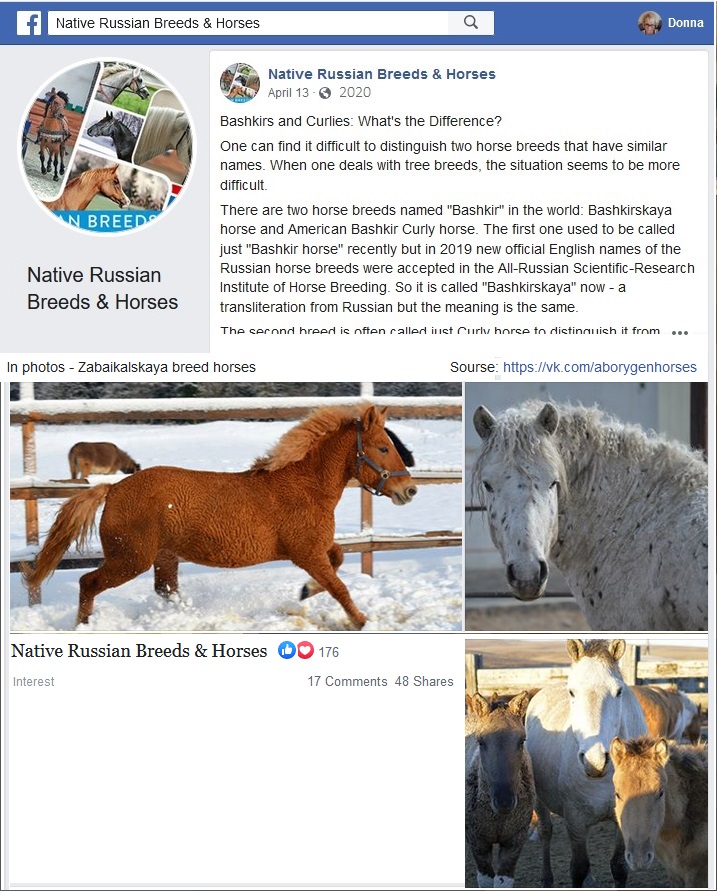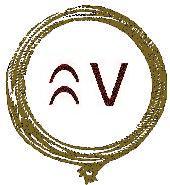Bashkirs and Curlies:
What's the Difference?
Bashkirs and Curlies: What's the Difference? · Native Russian Breeds & Horses · April 13 2020
Above is a screen shot of an excellent article posted in social media by a Russian Heritage Horse Group.
Below, I have included the entire copied and pasted text of that article.
Below that, is my (long) comment(s), that I also copied & pasted here.
“One can find it difficult to distinguish two horse breeds that have similar names. When one deals with three breeds, the situation seems to be more difficult.
“There are two horse breeds named "Bashkir" in the world: Bashkirskaya horse and American Bashkir Curly horse. The first one used to be called just "Bashkir horse" recently but in 2019 new official English names of the Russian horse breeds were accepted in the All-Russian Scientific-Research Institute of Horse Breeding. So it is called "Bashkirskaya" now - a transliteration from Russian but the meaning is the same.
“The second breed is often called just Curly horse to distinguish it from Russian Bashkirskaya horse. But mistakes are still sometimes made. That's why some breed associations, such as the International Curly Horse Organization (ICHO), do not use the name "Bashkir" at all. The oldest organization of breeders, the American Bashkir Curly Registry (ABCR) established in 1971 still uses the traditional name.
“What can we say about their origin? Russian Bashkirskaya horse is an old native breed from Bashkiria considered to be a mix of Asian native steppe horses and northern forest ones. Most Western specialists suppose that American Curly horse has Iberian ancestors so there is no family connection between American and Russian Bashkir horses.
“How did the word "Bashkir" became a name of an American breed? The fact is curly horses are very rare but they have been reported several times in different countries. When the American Curly breed was being consolidated some breeders learnt that curly horses had been discovered in Russia, somewhere near Bashkiria. They supposed that some Russian horses could have got to America... But it is probably not true. For example, Charles Darwin came across with curly horses in South America. Most of the local horses have an Iberian origin, too, so there is a higher probability that curly coats of Southern and Northern American horses have the same genetic source.
American Bashkir Curly horse is really a curly breed - and Russian Bashkirskaya horse is not. Few American Curly horses are not curly, but as long as that specific coat has been used as a trait for selection the most part of the population is curly after all. American Curly horses are said to be hypoallergenic - but the Russian ones are not.
It should be noted that curly horses really exist in Russia. This unique breed is called Zabaikalskaya horse. It originated in Transbaikal, an area that spreads to the east beyond the Baikal lake that is rather far from Bashkiria. This breed has a steppe origin. Many of Zabaikalskaya horses are really curly.
“In the territory of the former USSR we can find one more breed with some curly lines, that is Lokaiskaya horse originated in Tajikistan. It has steppe ancestors but has been improved with saddle breeds, for example with Arabian horse.
“Let us summarize: a breed called Bashkir Curly originated in the USA, and it is curly.
“A breed called Bashkirskaya (ex. Bashkir) originated in Bashkiria, Russia, and is not curly.
“A breed that is mostly curly and originated in Russia is called Zabaikalskaya horse.
“So it is not as difficult to distinguish three different horse breeds as it seemed to be at first.”
In photos - Zabaikalskaya breed horses; Sourse: https://vk.com/aborygenhorses (sadly, webpage is now missing)
Donna Grace {UPDATED June 2020}
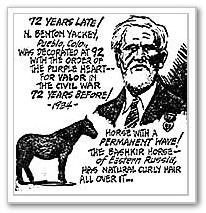 Thank you for this **wise** white paper article.
Many people who own and breed Curly Horses, are relatively new to horse ownership (due to their horse allergies) and are confused by the Bashkir reference. I started the International Curly Horse Organization (ICHO) in 1999 partly to help new horse owners understand the difference between Bashkirs and Curlies (among other more important reasons). Thank you for this additional verification from the Russian region that supports our teachings.
Thank you for this **wise** white paper article.
Many people who own and breed Curly Horses, are relatively new to horse ownership (due to their horse allergies) and are confused by the Bashkir reference. I started the International Curly Horse Organization (ICHO) in 1999 partly to help new horse owners understand the difference between Bashkirs and Curlies (among other more important reasons). Thank you for this additional verification from the Russian region that supports our teachings.
Decades ago, the American Bashkir Curly Registry (ABCR) had confusion because of a "Ripley's Believe It Or Not" cartoon in a newspaper, that featured a curly Russian Bashkir horse. That was not ABCs fault, and we never knew where that "fact" came from. The ABC became attached to their A-B-C name over the decades, and later when it became less likely that the North American Curly Horse came from Russia, they opted to keep their original name. Some breeders in Sweden imported Russian Bashkir (straight haired allergenic) horses to breed with their expensive imported American Curly horses, because it was much cheaper for them to import Bashkirs back then. They probably thought they were breeding the same breed. Even today, some Curly horses in Sweden are probably part Bashkir. And even today, the confusion of the "Bashkir" horse breed name still exists among people who are new to Curly Horses. Since many people who buy Curly Horses are allergic to other breeds, many owners are fairly new to horses altogether.
The late Sandy Hendrickson (owner of the famed Spartacus, of GreyCoat Farms, Indiana, and among the first group of women who helped me start ICHO), did some research on the Bashkir in Russia, and brought this home back then:
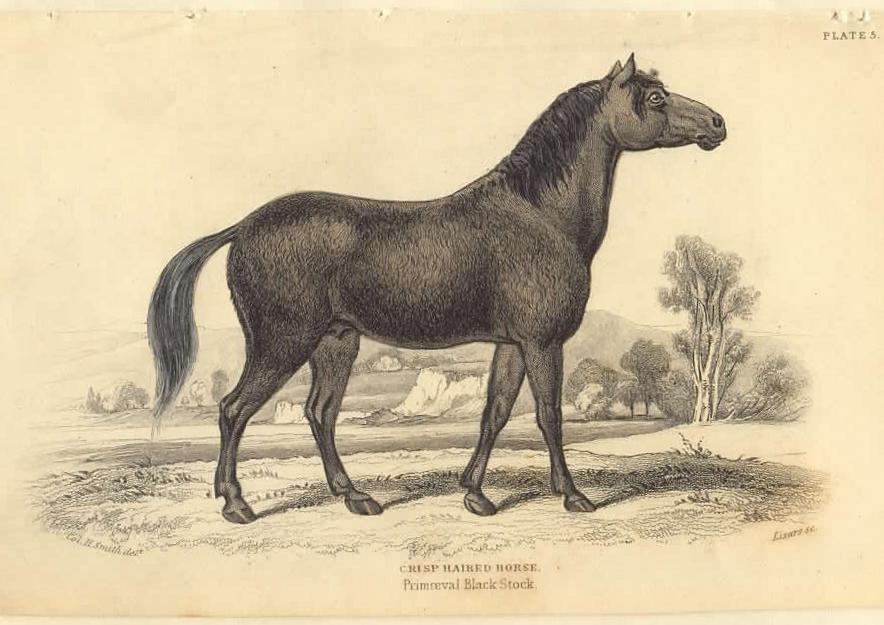
| This picture is of a "CRISP HAIRED HORSE (Primaeval Black Stock)" in The Natural History of Horses by Lieut. Col Chas Hamilton Smith: the equidae or genus equus of authors
by Smith, Charles Hamilton; Gesner, Konrad, 1516-1565, published in Edinburgh in 1841. This particular horse was a cross between a Bashkir and a French Black after being plundered by the French at the capture of Vienna and was described by Frederick Cuvier. This isn't a theory - just a fact - that enough Bashkir horses were curly to be described as "cheval a poil frize' in those years during the research for that 1841 book. When Shan Thomas did her research (Curly Horses; Myth & Mystery) there were no curly Bashkir horses at the Bashkiri Stud Farm in 1989 - hence her answer (no) from Scoto Imports. This sure doesn't mean that our horses are related to the Bashkirs in any way. Tom (DVM in NV? Hendrickson, her husband?) even helped with the research trying to find Russian horses on ships logs when the Russians settled in California about 1840. Couldn't find any. I personally have come to the conclusion that the curly gene probably did come up from South America-but always open to new info--Also not saying that curly coated horses from Russia couldn't have been introduced into Alaska on their Hunting trips and left behind when the ice melted and the Russians returned home by boat. Just leaves us with so many things to explore. sandy |
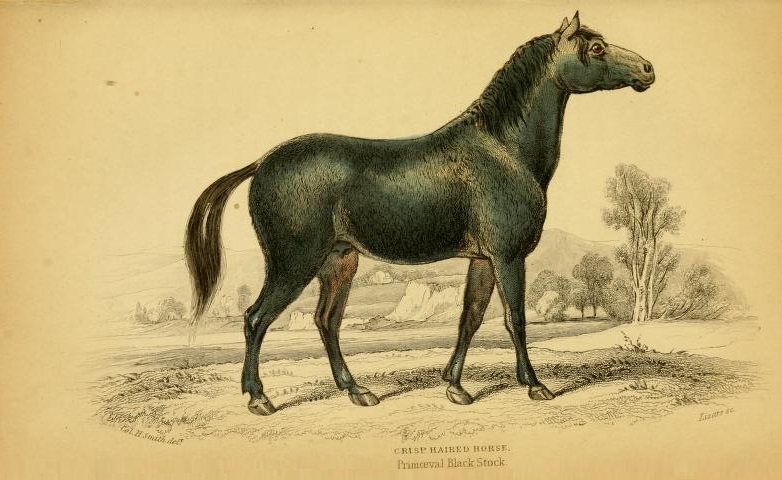
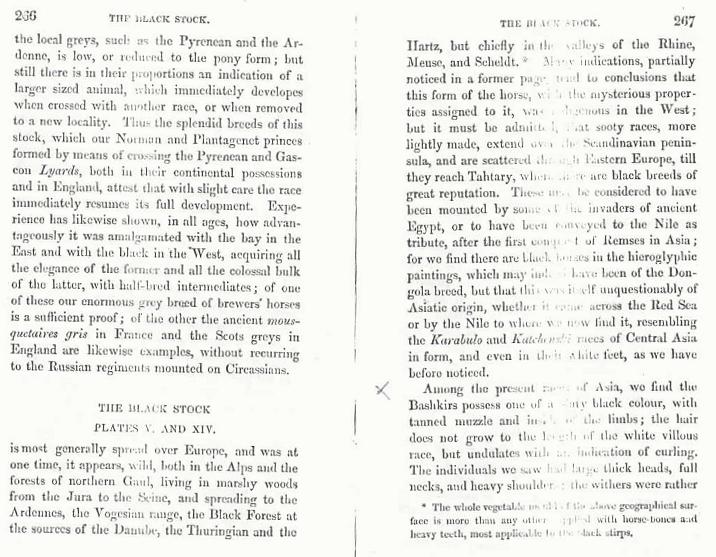
"CRISP HAIRED HORSE (Primaeval Black Stock)" in The Natural History of Horses by Lieut. Col Chas Hamilton Smith:
the equidae or genus equus of authors by Smith, Charles Hamilton; Gesner, Konrad, 1516-1565, published in Edinburgh in 1841
The recent genetic isolation of the S6 and the KRT25 dominant curly genes in American Curly populations, further demonstrated that the North American Curly Horse is actually several completely different breeds registered together by the same registries.
Evidence continues to show that other curly horses have also mutated and appeared among other breeds of horses, in other countries.
Takeaway:
There are 3 or more strains of dominant gene curly horses in North America.
1) The curly Missouri Foxtrotter (SP6), circa 1940s.
2) The old Native American curly horse line (KRT25) that has spread all over North America now. It was first documented in the 1700s in northwestern plains Indians' winter counts (calendars). The KRT25 Native American line of Curly Horses has been crossed with many breeds and other curly horses for decades. The few that are left share history and heritage with the old (also rare) Nokota horse, and has become all but extinct in its "pure" form now. The last few remaining "Berndt" bloodline horses are those that are left. The Bad Warrior bloodline horses are the Berndt horses crossed with old style original type Quarter Horses of early America.
3) The curly Sulphur mustang; almost extinct, as there are only a couple individuals alive of this line.
And possibly OTHER curly lines of horses in North America... that will take time to get isolated, and tell their stories.
Then, there are the Curly Criollos in the southern Patagonia region of Argentina in South America, which do not test positive for the 2 known North American mutations. That stands to reason if you understand how DNA mutations are inherited, and what they can tell us about the development of breeds (read more about DNA mutations and what they can tell you about the history of breeds).
Then, there are 3 known strains of dominant gene Curly Horses found in Asia:
1) The dominant curly Lokai (a Lokai bloodline that traces back to "Farfur," a sorrel curly stallion born in Tajikistan I believe in the 1950s; read more in Bonnie Hendrickson's book, International Encyclopedia of Horse Breeds)
2) There were some small curly horses found in the mountain region of Mongolia (we have photos)
3) Then, the curly line of the Zabaikalskaya breed of Russia.
And there was a family of dominant curly pinto horses discovered near Johannesburg, South Africa, a couple decades ago (we have photos) which may be extinct by now; I lost contact with those owners.
Now scientists will check the Curly Criollos, and the 2 Curly Cossack lines (the curly Lokai and the curly Russian Zabaikalskaya horses). We eagerly await those findings.
These extremely rare curly horse populations should be protected and preserved for prosperity, and should not be crossbred and blended away into extinction.
Right now, neither the ICHO nor the ABCR recognizes (**yet**) that there are several TYPES and BLOODLINES (i.e. breeds within the Curly Horse population) that should NOT be crossed together any more than the Russian Bashkir should have been crossed with the several American Curly horse breeds.
Scientists actually question now whether curly horse breeders over the years led to the extinction of several Curly Horse lines? We are not sure about that, but it has been offered as a possibility. We would like to prevent that from happening to the rare purer lines left now.
We have recently structured a studbook for international curly stockhorses within an organization that is committed to education and preservation of rare lines of horses, the international Heritage Horse association. We have been approached by other rare international breeds, as well, not just curly horses. We work to properly identify different breeds, and keep their breeding pure for posterity. We are now inviting any other registries to UNIFY their American Curly Horse studbooks and registries into one central organization and database, in the All Breed Database; and not to blend separate breeds, but to begin the work together to preserve them separately.
Please join us in this effort. Send email us with any questions to Heritage Horse Association; heritage.horse.assn@gmail.com.
![]()
HISTORY: Sandra Hendrickson's Research, 1990s
Subj: [ICHOCHAT] Re: North American Curly Horse origin
Date: 12/14/02 12:04:39 PM Mountain Standard Time
From: Lene@curly.no
Reply-to: ICHOCHAT@yahoogroups.com
To: ICHOCHAT@yahoogroups.com
Donna, Sandy and you others.
I think it is interesting that there might have been curly coated Basjkir ponies, just like in any breed where there might have been curly coated individuals. BUT there have been and still are curly coated horses in MANY breeds, but nobody gets us any closer to how the curls got to North America.
A little thought experiment. What if the earliest Curly breeders had known about the Lokai horses and called their breed for American Lokai Curly? Would that make it more likely that they were descendants from the Lokai horse?
Or if they had known that there have been curly coated Icelandics and called their horses for Icelandic Curly? Imagine what a mess when real Icelandics started to be imported to America. If all books and references said that the "Icelandic Curly" were descendants of curly coated Icelandic horses the vikings brought over (actually a more likely scenario than Basjkir horses wandering across a continent, crossing the Bering Strait and spread all the way down to South America during the last Ice Age). And a mix of the qualities of Icelandics and Curlies was presented as a breed description. Who wouldn't think that crossing curlies to the Icelandics would be the "right" thing to do, getting closer to the origin.
The Basjkir connection has been a disaster for the Curly horse in Sweden, just because of a name.
A couple of days ago I got an email from a Swedish girl who is allergic. With high hopes she had travelled to a Basjkir owner to test her allergy. The owner had said that "they were real such horses and hypoallergenic". She got an allergic reaction and was devastated. Untill she read a book (thank heavens for the hard work of the Curly horse breeders in Sweden, books have finally started to change!), who said that the Curly and the Basjkir were not the same breed, not even related. Then she went to the internet and found my website. What if she hadn't read that book? Or she had read an older book that stated for instance the following quote (picked from a website):
"Bashkir, or Bashkirshy pony, mares are often kept in milking herds in their native country, and have been known to produce 3 to 6 gallons of milk a day. This is highly prized milk, and as well as standard uses of milk, cream and butter, it is also made into a delicious cheese. The milk may also may be fermented into kumiss, which is used as an intoxicating drink and for medicinal purposes. Older animals are used for meat, and the hide is used to make clothing. The long, curly hairs can be spun into cloth. The Bashkiri don't even waste the bones. There are two types of Curlies which developed in Russia, a smaller mountain type pony and a larger steppe type horse. The difference may have occurred due to the amount and type of feed available in their respective areas. The curly coat may grow from 4-6" long in extremely cold climates. This characteristic, along with the extra layer of fat unique to the breed, these ponies are able to withstand harsh conditions and survive on scant rations."
Or read what it says in "The Ultimate Horse Book"; Elwyn Hartley Edwards; 1991.
The Bashkir Curly, or Bashkirsky, evolved centuries ago in Bashkiria, around the southern foothills of the Urals. There it is bred as a pack, draft and riding animal and to provide meat, milk and clothing. In a 7 to 8 month lactation period, one mare yields 330-350 imperial gallons. Moreover, the peculiarly thick, curly coat can be spun into cloth.
Two types have developed within the USSR, the Mountain and the Steppe Bashkir Curly. The former has been crossed with Dons and Budonnys, and the latter, a harness type, with both Trotters and Ardennais stallions.
There are 1,100 or so Bashkir Curlys registered in America. It has been claimed that they arrived on the American continent across the land bridge that is now the Bering Strait. However, that takes no account of the fact that the species Equus was extinct on the American continent after the Ice Age, which swept away the land bridge across the Bering Strait, and the horse was not reintroduced until the arrival of the Spanish conquistadores some 10,000 years later.
The hardy Bashkir Curly is kept outdoors and can survive winter temperatures of -22 to -44 degrees, and find food under 3ft of snow. A pair of Bashkir Curlys are said to be able to draw a sleigh 75-85 miles in 24 hours without being fed.
The principal feature of the Bashkir Curly, which is described as being docile and intelligent, is the very thick, curly, winter coat that enables it to survive in sub-zero temperatures. The principal colors are a red chestnut, bay and light brown. The practice of shoeing is not carried out in the Bashkir's natural habitat, the animals' hard hooves allows them to work under all kinds of conditions without shoes. The mane and tail is exceptionally thick. The head of the Russian Bashkir Curly is massive and set on a short, fleshy neck that runs into flat withers. The American version has been improved in these respects, and in recent years selective crosses have produced a better quality animal in the USSR. This horse is described in the official standard as being smalll with a wide body and a flat, straight back. The measurement around the girth for stallions is 71". The limbs of this solid little horse are comparitively short, and the official Russian breed standard quotes a remarkable bone measurement of 8" below the knee. The Bashkir Curly stands at 14hh.
It is easy for us that know curlies so well, to know what is true, what is probable and what is complete bullshit. But for other people it is not that easy, they will believe what they read and hear.
My prayer is; Please, let us not go back in time getting this terrible mixup back again. We have still long ways to go before it is accepted that the Basjkir and the Curly is not the same breed. Even if there has been curly coated horses among the Basjkirs, do NOT emphasize it. Do not emphasize connections with any other breed before we have proof.
It should be enough to state that:
"Through history, at least since 4000 years back in China, there have existed curly coated horses in a number of breeds. In modern time North America is the only place where we know that curly horses has been bred purposedly and to an extensive degree."
Lene (Norway)
|
published August 2020; author: Donna Grace
mailto:Heritage.Horse.Assn@gmail.com
